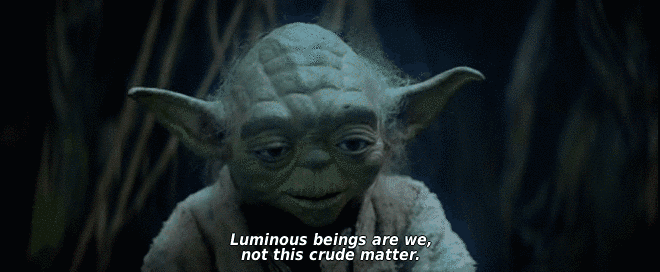star wars
One of the hallmarks of Ismaili philosophy is just how nebulous and ever-changing spirituality can be. When contrasted with conceptions from other schools of thought where the god is a figure and the soul is a person, it can be a little difficult to get a concise metaphor for the "hidden" realm in Ismailism. That is, until you watch Star Wars.
Just like it's tickled the fancy of neckbeards across the world, Star Wars has also gotten the gears turning of countless philosophers. It features a deep spiritual understanding of the universe that plays an integral role in the actions and motivations of the characters. It also ruins that spirituality with a half-baked biological explanation. And while Star Wars is rooted in East Asian and monomythical traditions, I can't help but see the overlap with many Ismaili concepts.
the force.
In case you're not already a Star Wars nerd, here's a quick crash course on the Force:
What's important to note is that the Force isn't limited to the Jedi and the Sith (Force users) it forms a basis for all life in the universe. Although, it seems that only force sensitive species can actually read into the Force, instead of just passively experiencing it, as well as influence the Force and even become a part of it.
If we line up George Lucas's descriptions of the Force with alSijistani's description of the intellect, we can start to draw comparisons. The Cosmic Force, which contains the Living Force, but also extends into eternity and infinity would be God, as described by alSijistani's Universal Intellect. The Living Force would be equivalent to the Individual Intellect because it comes from and returns to, while still being made of and growing into the Universal Intellect. Often times, the soul is described with the metaphor of an everlasting light, something that Master (مولى "mawla" in Arabic) Yoda also uses to describe the Force:
"...my ally is the Force, and a powerful ally it is. Life creates it, makes it grow. Its energy surrounds us and binds us."You must feel the Force around you; here, between you, me, the tree, the rock, everywhere, yes. Even between the land and the ship."
As it happens, Yoda also went on an immense spiritual journey during the Clone Wars. He travels to the Wellspring of Life, a nexus point in the center of the galaxy that is said to be the origin of all life in the universe. Yoda meets a manifestation of the Cosmic Force who've taken on the form of five maidens (حورية "houriah" in Arabic). During this journey, Yoda has to battle a dark version of himself (absolving himself of sin), traverse a valley of temptation (conquering his irascible soul). Yoda then has to travel to the Sith world, where he is forced to confront more illusions and moral dilemmas. The two-episode arc ends with Yoda realizing that there is more to life than the Clone Wars or the physical world, and that by pursuing his internal struggle (اجتهاد "ijtihad" in Arabic), he can continue into eternity as a Force ghost. This journey is a mystical journey for Yoda, that enlightens him to become a spiritual being after his death. All the things that Yoda does (struggle with the self, dispel illusions, etc) are things that Ismailis are encouraged to do to reach their own spiritual fulfilment through things like meditation.
midichlorians.
Of course, the Phantom Menace had to ruin everything by introducing the world to midi-chlorians. Midi-chlorians are microscopic beings created out of the Cosmic Force in the aforementioned Wellspring of Life. From there, they spread throughout the galaxy, inhabiting other lifeforms to create the Living Force and allow people (and aliens) to connect to the Cosmic Force. Because the midi-chlorians are pretty much quanta of the Cosmic force, the higher the concentration means the better the connection to the Cosmic Force. By counting the midichlorians in one's blood (Anakin had 20,000 which is more than anyone else), you can basically measure their connection with the Force. The Jedi use this test for recruiting.
Nasir adDin Tusi describes something similar when he talks about the soul. No, it's not magic bacteria; Tusi's description is of something non-physical. But similarly, Tusi's soul is what's responsible for all life in the universe and "how much" there is in an organism dictates not only its connection to the spiritual, but also the powers it has over its environment. Tusi describes a hierarchy of vegetable, animal, and human souls, each with a deeper and more powerful connection to the spiritual world. Any creature in Star Wars could be mapped to this hierarchy, with plants at the bottom (same as Tusi), the force sensitive at the top and scruffy-lookin' nerf herders somewhere in the middle.
Tusi estimates the position of the examples that he uses in his (he put black people below horses, you guys), but with midi-chlorians, you'd have a way of measuring how spiritual a person could be. However there is also a Quranic verse that talks about people who are unable to connect with God. Perhaps it's because they lack adequate midi-cholrians.
the jedi.
Honesty time: the reason I'm writing this is because I was watching re-runs of After Hours, specifically this episode:
Although the premise is that the Jedi are stupid, it can't be overlooked that the Jedi are very similar to another group from Ismaili history: the Fidai. The Fidai (commonly known as the Assassins) were a secretive group of Ismaili elites that were trained to fight in the Crusades. But they were far more than just fighters.
There are a number similarities between the two:
Indoctrinated into an order (potentially at a young age) they're not allowed to leave
Definitely not allowed to cave to carnal desires
Trained in close combat with specialized weapons in a mountain-like temple run by a mysterious old dude that's either incredibly wise or a little bit crazy
Emphasized their spiritual knowledge but involve their efforts almost completely in political actions
The Jedi Temple and Alamut had world-famous libraries that most people just gloss over, but hey! Libraries are cool!
Promoted a concept of unseen universal spirituality that not everyone believes in
Neat robes
In both cases, we have secretive, elite groups of mystical scholar/warriors using their fighting skills to further their own peace-emphasizing political agenda in the middle of wars that were started under power-hungry government officials with dumb names: Sheev Palpatine and Otho deLagery (guess which one's which). At the end of the war, the Jedi/Fidai are all but wiped out, their headquarters burned down (by a force widely considered more powerful than "sand people") with a few fleeing to some less-than-savory places.
"O Commander of the faithful! It's a land where the plains are stony; Where water is scanty; Where the fruits are unsavory; Where men are known for treachery; Where plenty is unknown; Where virtue is held of little account; And where evil is dominant. A large army is less for there; And a less army is use less there; The land beyond it (Sindh), is even worse" -Khalifa Umar bin al-Khattab
the sith.
Throughout the Star Wars movies, the Sith are generally considered the bad guys, corrupted versions of the heroes. However, there are attributes of their history and their status that reflect other attributes in Ismaili history. So, I'll be drawing comparisons, but that doesn't mean what I'm talking about is evil.
In Star Wars Episode III, we get an anecdotal look at what can motivate someone to become a Sith.
The main motivating factor, for people to become the Sith is to gain more power from the Force. Bear in mind, the Force is both light and dark, and the morality comes in how you use it. So, simply becoming more powerful in the Force wouldn't necessarily make someone evil. If we look at our above comparison between the Cosmic Force and God, we can see an example of people who are both very much connected to "the Force" but also possess powers some would consider to be unnatural. Contested as they are, there are plenty of stories of the Imams and the Pirs seeing into the future, disarming bombs with their minds, and even bringing people back from the dead (I recounted one such story in my Tasbihs post). I'm not going to argue if these stories are true or not, but many people believe them, and this is a religion, so what people believe counts.
The other parallel lies in the Sith's rules of governance, namely the Rule of Two. Darth Bane set up the Rule of Two so that the Sith don't get out of hand and start killing each other willy-nilly. The Rule of Two is basically says that there can only be two Sith at any given time: the master and the apprentice. Likewise, we can find many examples of the Imam being one of two in Ismaili history: the Imam and the Pir. While I don't think there's a history of the Pir overthrowing the Imam, or the Imam killing the Pir to find a new one, like the Sith do, we still have these two figures working together in both cases.
It's also important to note that while the Rule of Two doesn't apply to the Imamat today (there's no Pir) its dynamic is still prevalent in the practice of Dasond, where members of the congregation pay one tenth of their income as religious dues to the Imam, and another fortieth to the Pir.
conclusion.
Ismailism has history and traditions that are intricately intertwined with other cultures and religious practices. It's no surprise that there's a large overlap between this religion and something inspired by other religious practices, such as Star Wars. And historically speaking, Ismaili teachings have emphasized an entire worldview, in addition to the ethics and religious practices emphasized today. This worldview extends beyond any religious practice and into the fabric of the Universe itself.
Literature has always been a medium through which people express their understanding of the universe. Despite the laser swords and poor writing ("Are you an angel?"), we can see Star Wars as an expression of understanding. Imam Sultan Muhammad Shah, in his memoirs, cites Plato, Confucius, and others as having great insights into the meaning of life, and that Ismailis should learn from them. Perhaps, Ismailis can learn from the great Jedi Masters as well.
the last jedi: update
With the addition of the latest Star Wars Saga movie, we learn a lot more about the force and how it works. I can't explain it better than Luke, so I'll let him do it:
And in another fun parallel between Ismailis and Star Wars, Luke has a collection of sacred Jedi texts with him on the island. He venerates these texts and even Rey is in awe of them. However, when the texts are burned with the help of Master Yoda, Luke reveals that he hasn't actually read the texts. This isn't a historical parallel as much as it's a modern parallel. While all Ismailis embrace the idea of the continuation of God's message through the Imam, very few actually engage critically with the guidance in a way that they can apply it to their lives. And while many Ismailis venerate the original "sacred texts" (e.g. the Quran) very few have actually read them and, to quote Master Yoda, "page turners, they are not."
Nasir adDin Tusi describes this phenomenon in section 50 of his spiritual autobiography Contemplation and Action. Tusi describes those who have "accepted the revelation divides into two groups: one who attends to the command, the other who attends to the commander. It is in terms of this distinction that the hypocrites are separated from the faithful." Tusi argues that the command changes to adjust to the time, and those who are faithful must follow the changing command. Bringing it back to Star Wars, Luke has an antiquated notion of what the force can be (diametrically opposed good and evil) and he clings to his ancient books; he would be considered an exotericist by Tusi. Rey on the other hand has a more fluid understanding of the Force (a more blurred line between good and evil) and she attends to this changing notion; Tusi would consider her an esotericist.
And hey! Since you made it to the end of this post, why not treat yourself to some Obi-Ali merch!
It’s the perfect design for lovers of early Islamic History and Star Wars (since you made it this far, I’m assuming that you like both).
Find this and many other designs on my RedBubble Store.













